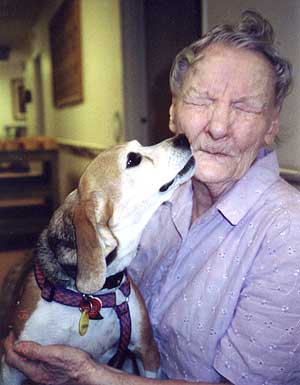Playing With Our Cat Helped Her Get Well
 When we first got our now 15 year old tuxedo cat, she was a frail, too-thin kitten. At about 8 weeks old, she was half the size of the other kittens in a feral cat colony we had been watching and supporting. I couldn’t stand by and watch that one die as the others prevented her from eating, and actually beat her up from time to time. So I snatched her one morning, which wasn’t as easy as I thought it would be. She still had some strength and good reflexes. But I knew that wouldn’t last much longer. It was time for an intervention!
When we first got our now 15 year old tuxedo cat, she was a frail, too-thin kitten. At about 8 weeks old, she was half the size of the other kittens in a feral cat colony we had been watching and supporting. I couldn’t stand by and watch that one die as the others prevented her from eating, and actually beat her up from time to time. So I snatched her one morning, which wasn’t as easy as I thought it would be. She still had some strength and good reflexes. But I knew that wouldn’t last much longer. It was time for an intervention!
I had to sneak up behind her and throw a towel over her and immediately scoop her into my arms, then into a box, since we did not have a trap. She put up an amazing fight and I was astonished at her spunk. But she had never been touched by a human before. She was completely terrified. And she wasn’t just the runt of the litter, either. Her head appeared to be permanently turned and tilted to the right. Someone else had been calling her “that twisted neck cat,” so we named her Twister.
It took a few weeks, but she soon became very tame and fun to have around the house. She played with everything. Shoelaces weren’t safe, and anything dangling or left on the floor, such as a newspaper, or a jacket hanging on a chair, was an invitation to dive underneath it. So we invested in a few toys made just for cats, but also with a view to helping her develop certain physical skills and coordination.
As a physician, I decided to use her playtime drive as a means of physical therapy to correct her neck problem. It looked like a torticollis to me, a condition in which muscle spasms become permanent and the neck cannot be turned normally, and as a chiropractor, I had helped a number of patients recover from exactly the same thing.
So I created a play routine that involved forcing Twister to look both ways, and to chase a toy to either side, with a quick change of direction so she didn’t have time to think about it. In addition, I used some massage and acupressure techniques to release the muscle rigidities and allow her to use them more.
It took most of her first year, but she came out of it quite well, with only a slight twist of her head left to remind anyone of her beginnings.
Now, at 15, she has no twist whatever, but she apparently had some congenital neurological damage from which she could not recover. She is now completely deaf, for example. And she’s still a very small cat. But she’s the lucky one… none of her litter mates, nor parents, are alive today. As ferals, they lasted the “normal” year or three and gradually disappeared, as ferals often do in the sometimes hazardous outdoor life. And while we weren’t able to capture all of them for spaying and neutering, we became advocates and volunteers for a local trap-neuter-release program to help control the stray population.
Meanwhile, Twister has lived a most fulfilling life as she became our constant companion on our many trips all over the United States.
